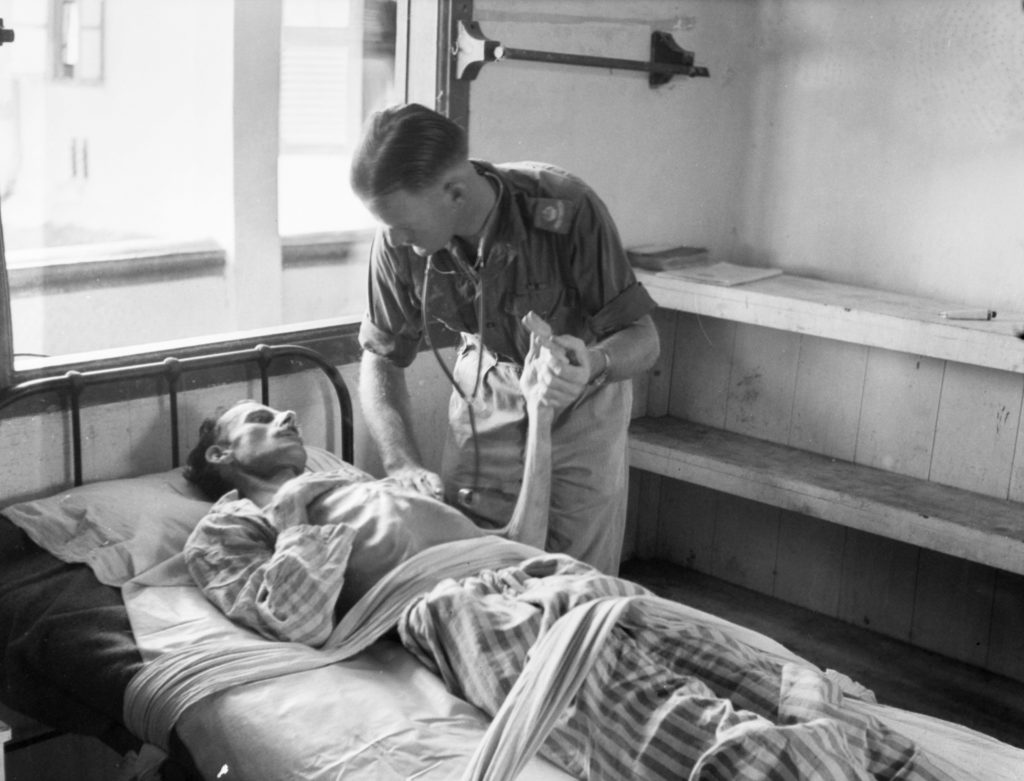My father Medwyn Hutson was a Medical Officer in the Second War. He served in Syria, where Australians were fighting the Vichy French, New Guinea and Borneo. In Borneo he was part of a mercy mission that flew in by flying boat to a POW camp in Kuching before the Japanese surrender. He found it a very emotional experience after the plane and river journey to encounter the deference and cooperation of the Japanese, and the overwhelming misery, problems and courage of the prisoners.
He always thought that his involvement in this mission was the highlight of his medical contribution to the army.
And on other matters. Those who have followed my cardiac adventures in the books or on the blog may be interested to know that I had “a turn” last week. I have a loop recorder in my chest which monitors my heart rate and sends a message to the cardiologist if anything goes wrong. It sent off a message to Sparksy and I was summoned to his rooms on Monday. The recording showed that I had flatlined for 10 seconds, a small blip, then another flat line of 3.6 seconds. No wonder I had felt like I was at death’s door! 24 hours later I had a pacemaker in my chest and 24 hours after that I was back home! And the best thing is the battery lasts for 12 years! That should see me out. But I’ll have to miss Flemington today. I’m not allowed to drive for two weeks.
Isn’t modern medicine amazing! Lest we forget.




(Geoffrey, I have slightly amended the second paragraph, so could you kindly delete my previous post)
Dear Geoffrey
Hope the recuperation is going well. It’s great that you have such close access to medical support. I agree that we do take certain things for granted, health & medicine being one of them. I have recently semi-retired so I now make sure that I go for a decent walk every morning, up three steep side roads, and up a steeper hill on an open piece of land, finishing off with trying to find 12 cattle (rare breeds I think) in one of the neighbouring fields (grazing on common land). I remember you saying to me sometime ago “That it was good to walk”!
Racing here seems to be going through, to put it politely, an interesting phase which I mentioned in a previous post. I wish there was more funding for rehoming of racehorses here. One racehorse charity was able to advertise on a morning racing programme shown on terrestrial TV in late February (to a two hundred thousand plus audience) and sent a tweet during the Cheltenham festival (UK’s premier jumps meeting) in March but it didn’t generate many donations.
The Irish did extremely well at the festival, so questions have been raised. You do come across posts on certain racing forums about the less savoury aspects of the sport. Sometimes you just want the authorities to get a grip.
The flat racing season is now in full flow here, and gradually racecourses will open again to the public. The first two classics for three-year-old colts and fillies (2,000 and 1,000 Guineas respectively) over a mile take place at Newmarket on Saturday.
I see that the entry rules are being tightened for participation of international runners in the Melbourne Cup following recent fatalities. There will be mandatory diagnostic screening of horses in future. Anything that reduces the risk to racehorses should be welcomed.
All the best
Trevor
Geoffrey,
Returning to my last point about tightening the rules for Melbourne Cup participation. I have just started reading “The Black Horse is Dying” by William Jones. It’s not very edifying – currently I’m reading the chapters on racing in the US. I felt I needed to read it rather than burying my head in the sand. The author does praise Australia for its higher racehorse welfare standards (much higher than the US). Even in the British Isles I suspect there’s quite a lot of catching up still to be done.
Best wishes
Trevor
Lasix, the anti-bleeding drug used in the US, is banned here.
Dear Geoffrey,
Some trainers in the US seem to have a rather extended history of racehorse drug abuse including some inducted into the US Hall of Fame! Each state has its own jurisdiction which does not help. New York has come down harder than most probably because of articles appearing in the New York Times (an example of great investigative journalism). I would like all trainers in the British Isles (including Eire) to promise never to use drugs banned in the UK/Eire when sending horses to race in the US or elsewhere. It would good if trainers chose never to race their horses on dirt, which is an unforgiving surface after rain, removing the top surface and leaving a hard-base underneath.
We have artificial (all-weather) surfaces here e.g. Polytrack, tapeta, which are much better. Some tracks in the US moved over to artificial surfaces but were “persuaded” to go back to dirt. I believe the same happened at the Medyan (Dubai) racetrack. The local racecourse I attend uses Polytrack which produces a surface akin to ground on the slow side of good (standard-to-slow), regains its shape after racing and has limited kickback. These surfaces hopefully cause less stress on horses’ tendons.
By the time you return in October turf flat racing will be coming to an end here, although all-weather flat racing continues throughout the winter months. The class of racing is lower (as mentioned before) but occasionally you might get a decent maiden race (the great race mare Enable started off in an all-weather race over a mile at Newcastle in November 2016). It’s always a good time for me take stock (my equivalent of going to The Gold Coast!).
All the best
Trevor